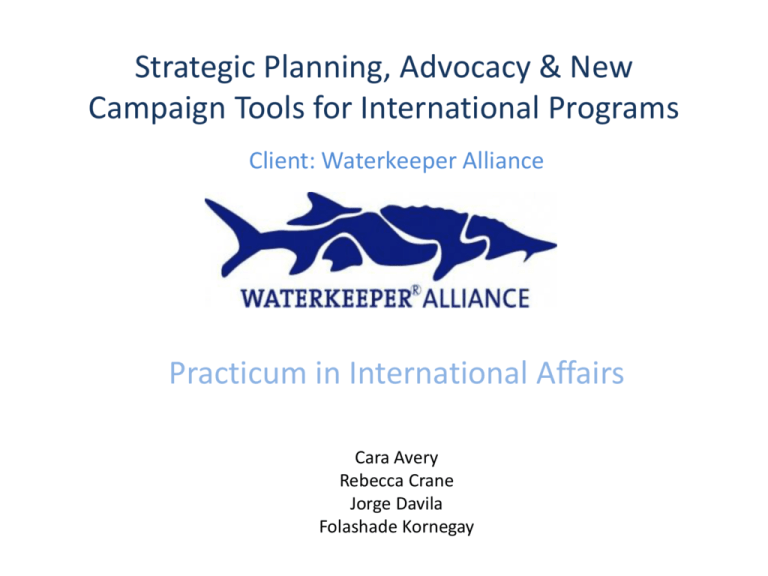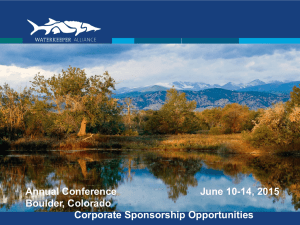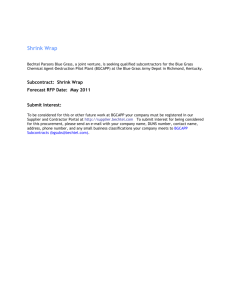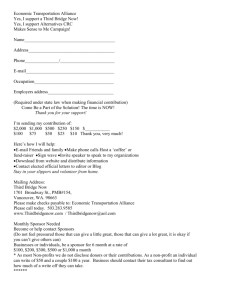Presentation - Milano School
advertisement

Strategic Planning, Advocacy & New Campaign Tools for International Programs Client: Waterkeeper Alliance Practicum in International Affairs Cara Avery Rebecca Crane Jorge Davila Folashade Kornegay Who is Waterkeeper Alliance? • Waterkeeper Alliance is an NGO that provides a way for communities to stand up for their right to clean water and for the equitable use of water resources • They employ strategies such as targeted advocacy, campaigns, media outreach, public education, and litigation to prosecute water polluters in a court of law Our Role: The New International Platform • Traditionally, Waterkeeper Alliance has been a national, US-based environmental NGO with satellite WKOs that have recently formed all around the globe • As of January, the Waterkeeper Alliance headquarters in NYC hired their first ever International Director to transition their platform from a national to international one • Waterkeeper Alliance contacted GPIA to carry out their new mission of supporting their international network of WKOs Map of Existing Global Waterkeeper Organizations (WKOs) Source: Waterkeeper Alliance What Was The Project? The Problem • At the onset of their new international endeavor, Waterkeeper had no way of knowing how to assess and strategize their resources and capacity in the international arena • This collaboration was born out of the international expertise of GPIA students and Waterkeeper’s desire to grow internationally The Solution • After meeting with the new Waterkeeper International Team, we came up with a description of our final work product and the following timeline of deliverables – roughly broken up into 2 parts. The Deliverables/Our Product PART 1: ASSESSMENT OF NEEDS BY REGION Latin America & Caribbean Africa & the Middle East Europe Asia & Australia PART 2: ADVOCACY/CAMPAIGN TOOLKITS Timeline of Deliverables PART 1: REGIONAL NEEDS ASSESSMENT PART 2: ADVOCACY CAMPAIGN TOOLKITS A. Gaps & Weakness Analysis A. Fact sheet of Legal Rights • National • International Agreements • Case Law & Precedents B. Legal Frameworks • National • Regional • International B. Talking Points for Letters to the Media C. Case Studies C. Identification of Possible Partnerships D. Potential Funding Sources • Country-Specific • International Part 1A of NEEDS ASSESSMENT: Gaps & Weakness Analysis • Today, water resources are declining in quality and quantity in virtually every part of the world: More than a billion people are living without access to safe drinking water. • Our regional assessments provided a detailed country-by-country profile of water needs and issues such as pollution, scarcity, over-exploitation, lack of access, the lack of water rights, and poor management. Source: UN Water Source: UN Water Source: UN Water 1A Example: Needs Assessment of Water Issues Asia • Asia is home to 60% of the world’s population, but only 36% of the world’s freshwater resources. • With a growing population, high levels of urbanization, and increasing levels of development, demand for water is on the rise in Asia: over the past 50 years, demand has increased by 300%. Europe • Nitrogen fertilizers lead to agricultural run-off and seep into water sources. • Nitrogen pollution negatively affects the environment and causes major health risks to both humans and animals. Part 1B of NEEDS ASSESSMENT: Legal Frameworks • There are a number of commitments in place to uphold water law on an international level, the general principles of international water law have emerged from customary international law and various water-related agreements. • At the national and regional levels, some governments have undertaken commitments to protect their water resources and the rights of their citizens to have water. • We provided a quick reference guide to the commitments governments in each region have undertaken at the international, regional and national levels. Part 1B Example: National Water Law in the Czech Republic Part 1B Example: Regional Framework - Indus Water Treaty • A bilateral water treaty between India and Pakistan struck in 1960 • Established the Permanent Indus Commission to adjudicate any disputes • Strictly controls the amount of water India can extract from rivers upstream Ongoing disputes over the quantity of water being extracted led to the appointment of a neutral expert in 2005 to decide the case of the Baglihar Dam in Kashmir. In 2012, both countries agreed to form an independent Indus Water Commission, staffed by neutral experts. Part 1B Example: International Legal Frameworks On an international level, water has been identified as an important factor in achieving development, and is strongly connected to poverty alleviation, environmental sustainability, and urban planning. • Millennium Declaration (2000) • Agenda 21 (2002) • UN Convention on the Law of the Nonnavigational Uses of International Watercourses (1997) • UN Convention to Combat Desertification in Countries Experiencing Serious Drought and/or Desertification, Particularly in Africa (1994) Part 1C of NEEDS ASSESSMENT: Case Studies • Regional case studies were requested by the client to help get a clear picture of what has worked and what hasn’t, so that they can better serve the communities they work with. • Waterkeeper Alliance is focusing on both legal and grassroots examples so that they can discover multiple ways to engage all stakeholders equally. Source: FAO Part 1C Example: Case Studies in Africa While the continent of Africa suffers from a number of issues tied to water access and quality, there have been a number of declarations made by African governments to combat the issues • Africa Water Vision 2025 • eThekwini Declaration (2008) • Tunis Declaration (2008) • Sharm el-Sheikh Declaration (2008) Lack of political will stalls progress in achieving goals and perpetuates the same issues, and the advocacy of the people has been instrumental in pushing the agenda forward Timeline of Deliverables PART 1: REGIONAL NEEDS ASSESSMENT PART 2: ADVOCACY CAMPAIGN TOOLKITS A. Gaps & Weakness Analysis A. Fact sheet of Legal Rights • National • International Agreements • Case Law & Precedents B. Legal Frameworks • National • Regional • International B. Talking Points for Letters to the Media C. Case Studies C. Identification of Possible Partnerships D. Potential Funding Sources • Country-Specific • International Part 2A of TOOLKIT: Fact Sheet A fact sheet is about alerting the community about their “right to know” laws and includes pertinent statistics about health and economics • • • • Constitutional Human Right to Water National/Federal Water Laws and Acts Judicial Court Decisions and Rulings International Agreements (Ratified) Part 2A Example: Bolivia 1. The Law for Mother Earth / Law No. 300 • Antecedent: Bolivian Constitution of 2009 includes in Article 16; that every person has the right to water- passed by Evo Morales’ government. • In October 15, 2012 The Plurinational Legislative Assembly enacted The Law for Mother Earth. • Law No. 300 declares: “Mother Earth is consider sacred; it feeds and is home that contains, sustains and reproduce all living things, ecosystems, biodiversity and the individuals that compose them Part 2A Example: Bolivia 2. Legal Case: Bechtel v Bolivia (2001) World Trade Bank Court Antecedents: • In 1997, the World Bank conditioned aid for water projects upon the privatization of the water system of El Alto/La Paz and the city of Cochabamba. • In 1999, the Bolivian Government turned over Cochabamba’s water system to the Bechtel Company. • An increase of water rate by the Bechtel company sparked an aggressive citizen mobilizations in Cochabamba and around the country. Consequences: • Bechtel was forced to leave Bolivia. • Bechtel took the case to the International Centre for Settlement of Investment Disputes which is operated by the Word Bank • In 2006, the Bechtel Company abandoned the case as a direct result of global public pressure Part 2B OF TOOLKIT: Talking Points to the Media The talking points highlight issues that should be presented in order to strengthen the case for water protection when writing a letter to a public official or any type of news media. For example: • What does access to safe water sources mean for the livelihood of people who live within WKO countries? • How many children die of water related deaths each year? • How much water is used for agricultural uses? • What are the sources of pollution? Part 2B Example: Sample Letters Sample Letter for Senegalese Official AUSTRALIA: TALKING POINTS FOR LETTERS TO THE MEDIA [Date] Sample Letter to Public Official [Full name and title of Public Official] [Office Address] [ Date ] [ City Hall/ Municipal Office Address ] [ Public Official’s Title ] Dear [Mr./Ms./Mrs. and last name], Dear [ Public Official ]: Australia is the world’s driest inhabited continent, and during the period from 2000 to 2010, Australia was in the midst of an extended drought. With changes in global weather patterns due to climate change, 1 these extremes weather patterns are likely to be exacerbated in coming years. While Australia as whole uses only 5% of its total renewable water resources, usage is highly uneven 2 across the continent—in some regions usage is as high as 50%. 3 Total water withdrawal per person (1,152 m /inhabitant/year) is higher than in most OECD countries 3 (only New Zealand, Canada and the US rank higher). In 2005, over 60% of total run-off occurred in northern Australia, and only 6% of the total run-off 4 occurred in the Murray-Darling Basin, which accounts for 50% of Australia’s water usage. Though floods in 2010 alleviated the drought the region was suffering, water levels have yet to reach 5 environmentally sustainable levels. Water flow is a serious concern for many of the country’s rivers. For instance, the Murray River does not 6 flow 40% of the time. 74% of total water withdrawals go to agriculture, 16% to municipal withdrawals and 11% to industrial 7 withdrawals. Nutrient and suspended-sediment levels are higher in 90% of river lengths assessed than they were prior to European settlement. Based on national guidelines, parts of all drainage divisions have exceedences 8 in turbidity, salinity, pH, total nitrogen and total phosphorous. My name is (insert name here) and I am from (insert residence/location and or representing organization), and I write this letter as a concerned citizen. Water is important in sustaining life and a necessity for growth and poverty reduction, as noted by the United Nations, for which our country is a member state, and is evident in everyday life here in Sénégal. Our government has created a number of policies to address the needs of its citizens but it seems that political will remains lagging. Examples of such are: Sincerely, 1 State of the Environment 2011 (SoE 2011). Australian Government—Department of Sustainability, Environment, Water, Population and Communities. http://www.environment.gov.au/soe/2011/report/index.html 2 Ibid. 3 Ibid. 4 “What is our total water resource?” Australian Water Resources 2005. http://www.water.gov.au/WaterAvailability/WhatIsOurTotalWaterResource/index.aspx?Menu=Level1_3_1 5 State of the Environment 2011 (SoE 2011). Australian Government—Department of Sustainability, Environment, Water, Population and Communities. 6 Ibid. 7 FAO. 2012. AQUASTAT database - Food and Agriculture Organization of the United Nations (FAO). Website accessed on [14/11/2012 3:25] 8 State of the Environment 2011 (SoE 2011). Australian Government—Department of Sustainability, Environment, Water, Population and Communities. 1 Recurrent storm water flooding is the most serious natural hazard our country faces, and is further exacerbated by unplanned urbanization, the lack and/or obstruction of drainage systems and rising groundwater1. Every year, our country’s poor infrastructure fails to accommodate its citizens, especially the poor, who often settle in low lying areas and are therefore more vulnerable. In August, an estimated 18 lives were lost due to floods as a result of drowning or being crushed by falling buildings.2 In April of 2012, our government representatives pledged their continued commitment to The Paris Declaration and the Accra Declaration on the effectiveness of aid, as well as the eThikwini Declaration and action plan which calls for a minimum of 0.5% of the GDP devoted to better sanitation and water resource management. Currently, international development aid finances 85%3 of investment in the water supply and sanitation sector, but our country’s financial woes continues to deprioritize the need for proper disaster preparedness and put our lives at risk and in perpetual poverty. As a country, we are a water-rich nation, and in April of 2012, representatives of our government stressed that a “right to water” be promoted throughout the country and included in the impending update to the Water Code (Act No. 81-13), yet only 5.7% of our renewable resources are being used for the population, while our finite water resources continue to be stressed by overused, maintaining stress on the population and increasing the causality of preventable diseases such as malaria, cholera, and intestinal parasitosis. World Bank. Project Information Document Appraisal Stage: Stormwater Management and Climate Change Adaptation Project. 2012. 2 (Sewell 2012) 3 AMCOW. Water Supply and Sanitation in Sénégal: Turning Finance into Services for 2015 and Beyond. http://www.wsp.org/sites/wsp.org/files/publications/CSO-Sénégal.pdf Part 2C of TOOLKIT: Potential Partnerships To help Waterkeeper establish networks of WKOs, we identified organizations nationally, regionally, and internationally that participate in water advocacy on various levels Part 2D of TOOLKIT: Potential Funding Sources To fund initiatives in various countries, we identified a number of organizations and government agencies that have previously provided support for environmental or water-related projects In Conclusion: How Our Work Will Be Utilized • As of December 3, 2012, we handed off our final product and received excellent feedback from the International Director, Sharon Khan: “These toolkits are great! Thank you!! They are so full of information that I need to know to be strategic in going forward with our International Program. The sample letters are very useful as I prepare letters for individual international WKOs to declare its solidarity with WKA in the 2013 International Year of Water Cooperation.” Sharon Khan International Director Waterkeeper Alliance 17 Battery Place Suite 1329 New York, NY 10004







